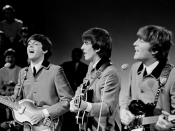"A Taste of Honey" by Shelagh Delaney is always remembered as her best piece of writing. This was one of the British plays of the 1950s that helped shape our perceptions of that age. Delaney's first, adolescent play was written in the late 1950s, when Britain was recorded in black-and-white - or, at least, that is how it is remembered from films of the period, notably Tony Richardson's 1961 version, with Rita Tushingham, Dora Bryan and Murray Melvin. Its influence, strong enough on the basis of Joan Littlewood's famous stage production in 1958, passed even more deeply into the popular consciousness thanks to Tony Richardson's classic screen adaptation in 1961. Richard Beecham's welcome revival of this sad tale of a feckless mother, difficult, dreamy daughter and the possibilities of love across racial and traditional gender divides recaptures the gritty, grainy atmosphere of the original and its Salford setting.
Gemma Craven draws us in as the blowsy mother, always looking for the next drink, the next bit of male company, and dragging her love child behind her. Kaye Wragg, however, is too attractive, too much the confident modern actress, to catch the gawkiness of Jo, the lonely girl who falls for a black sailor, with the inevitable pre-pill results. (Richardson 1-2) Mark Springer handles this seduction sensitively, and the play takes off in the second half when Ashley Artus appears as the queer (this is long before the days of being gay) art student who moves in to mother the pregnant Jo. The radicalism of the play, with its sympathy for black-white relations and homosexuals, points to the more liberal 1960s. What this production admirably shows is that human feelings come in deepening shades of grey.
It has been described as a female version of John Osborne's "Look Back...


